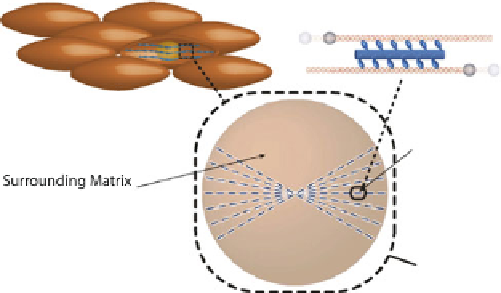Biomedical Engineering Reference
In-Depth Information
Fig. 4.5
According to Murtada et al. (
2010b
), smooth muscle cells are modeled through 'represen-
tative micro-spheres' which are divided into active and passive components. The active component
is defined by the contractile units that are oriented in different directions and with a certain orienta-
tion density. The passive component is modeled by elastin and collagen fibers aligned in the main
direction of the contractile units
where
λ
λ
2
2
χ(λ
−
1
λ
2
)
1
/
2
, and
χ
=[
+
−
]
∈[
0
,
1
/
3
]
is a dispersion parameter of
the form
π
π/
2
0
ρ(θ,γ)
sin
3
θ
d
θ,
χ
=
(4.14)
(cf. Gasser et al.,
2006
). For a detailed description of the choice and fitting of the
orientation density function
ρ
see Murtada et al. (
2010b
).
The material parameters were estimated to fit the experimental data of active
isometric tension development performed at two different muscle stretches,
μ
a
L
o
=
22
.
96 MPa,
η
=
=
=
0
.
016. To study the effect of
different orientation density functions
ρ
, the simulation was repeated for different
values of
γ
, see Fig.
4.6
.
When studying the length-tension behavior by modeling the stretch-dependent
agonist sensitivity and the contractile unit orientation density function in smooth
muscle, it was found that agonist sensitivity had a more significant effect on the
length-tension behavior than the dispersion of the contractile units. The stretch-
dependent agonist sensitivity could alone explain the length-tension behavior at the
two studied muscle stretches. However, the
2
.
215 GPa s,
κ
0
.
451 MPa and
χ
Ca
2
+
]
i
transient was only studied at two
muscle stretches and it would be more convincing to study the agonist-sensitivity in
smooth muscle with a more detailed set of experimental data of the
[
Ca
2
+
]
i
transient
behavior for larger range muscle stretches. The length-tension behavior of smooth
muscle exists for both agonist stimulations and membrane depolarization. However,
studies show little significant change in the myosin phosphorylation behavior during
potassium depolarization at different muscle lengths (Wingard et al.,
1995
), which
contradicts a length-dependent sensitivity during membrane depolarization.
[






